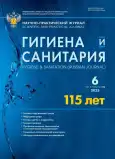Краткосрочные и долгосрочные эффекты пренатального воздействия торфяного дыма
- Авторы: Вокина В.А.1, Соседова Л.М.1, Панкова А.А.1, Абрамова В.А.1, Рукавишников В.С.1, Савченков М.Ф.1
-
Учреждения:
- ФГБНУ «Восточно-Сибирский институт медико-экологических исследований»
- Выпуск: Том 104, № 6 (2025)
- Страницы: 710-716
- Раздел: ГИГИЕНА ОКРУЖАЮЩЕЙ СРЕДЫ
- Статья опубликована: 15.12.2025
- URL: https://modernonco.orscience.ru/0016-9900/article/view/691559
- DOI: https://doi.org/10.47470/0016-9900-2025-104-6-710-716
- EDN: https://elibrary.ru/zeyzka
- ID: 691559
Цитировать
Полный текст
Аннотация
Ключевые слова
Об авторах
Вера Александровна Вокина
ФГБНУ «Восточно-Сибирский институт медико-экологических исследований»
Email: vokina.vera@gmail.com
ORCID iD: 0000-0002-8165-8052
Лариса Михайловна Соседова
ФГБНУ «Восточно-Сибирский институт медико-экологических исследований»
Email: sosedlar@mail.ru
ORCID iD: 0000-0003-1052-4601
Анна Александровна Панкова
ФГБНУ «Восточно-Сибирский институт медико-экологических исследований»
Email: anna.tropnikova.96@bk.ru
ORCID iD: 0000-0002-6012-0173
Вера Александровна Абрамова
ФГБНУ «Восточно-Сибирский институт медико-экологических исследований»
Email: tyutrina.v.a@yandex.ru
ORCID iD: 0000-0002-9406-5424
Виктор Степанович Рукавишников
ФГБНУ «Восточно-Сибирский институт медико-экологических исследований»
Email: rvs_2010@mail.ru
ORCID iD: 0000-0003-2536-1550
Михаил Федосович Савченков
ФГБНУ «Восточно-Сибирский институт медико-экологических исследований»
Email: mfs36@mail.ru
ORCID iD: 0000-0002-1246-8327
Список литературы
-
Confalonieri U., Menne B., Akhtar R., Ebi K.L., Hauengue M., Kovats R.S., et al. Human health. In: Parry M.L., Canziani O.F., Palutikof J.P., van der Linden P.J., Hanson C.E., eds. ClimateChange 2007: Impacts, Adaptation and Vulnerability. Contribution of Working Group II to the Fourth Assessment Report of the Intergovernmental Panel on Climate Change. Cambridge: Cambridge University Press; 391–431: 2007. Langmann B., Duncan B., Textor C., Trentmann J., van der Werf G.R. Vegetation fire emissions and their impact on air pollution and climate. Atmos. Environ. 2009; 43: 107–16. https://doi.org/10.1016/j.atmosenv.2008.09.047 Wu J., Winer A., Delfino R.J. Exposure assessment of particulate matter air pollution before, during, and after the 2003 Southern California Wildfires. Atmos. Environ. 2006, 40: 3333–48. https://doi.org/10.1016/j.atmosenv.2006.01.056 Fisk W.J., Chan W.R. Health benefits and costs of filtration interventions that reduce indoor exposure to PM2.5 during wildfires. Indoor Air. 2017; 27(1): 191–204. https://doi.org/10.1111/ina.12285 Delfino R.J., Brummel S., Wu J., Stern H., Ostro B., Lipsett M., et al. The relationship of respiratory and cardiovascular hospital admissions to the southern California wildfires of 2003. Occup. Environ. Med. 2009; 66(3): 189–97. https://doi.org/10.1136/oem.2008.041376 Loomis D., Grosse Y., Lauby-Secretan B., El Ghissassi F., Bouvard V., Benbrahim-Tallaa L., et al. The carcinogenicity of outdoor air pollution. Lancet Oncol. 2013; 14(13): 1262–3. https://doi.org/10.1016/s1470-2045(13)70487-x Huttunen K., Siponen T., Salonen I., Yli-Tuomi T., Aurela M., Dufva H., et al. Low-level exposure to ambient particulate matter is associated with systemic inflammation in ischemic heart disease patients. Environ. Res. 2012; 116: 44–51. https://doi.org/10.1016/j.envres.2012.04.004 Liu J.C., Pereira G., Uhl S.A., Bravo M.A., Bell M.L. A systematic review of the physical health impacts from non-occupational exposure to wildfire smoke. Environ. Res. 2015; 136: 120–32. https://doi.org/10.1016/j.envres.2014.10.015 Milton L.A., White A.R. The potential impact of bushfire smoke on brain health. Neurochem. Int. 2020; 139: 104796. https://doi.org/10.1016/j.neuint.2020.104796 Schuller A., Montrose L. Influence of woodsmoke exposure on molecular mechanisms underlying Alzheimer’s disease: existing literature and gaps in our understanding. Epigenet. Insights. 2020; 13: 2516865720954873. https://doi.org/10.1177/2516865720954873 Abdo M., Ward I., O’Dell K., Ford B., Pierce J.R., Fischer E.V., et al. Impact of wildfire smoke on adverse pregnancy outcomes in Colorado, 2007–2015. Int. J. Environ. Res. Public Health. 2019; 16(19): 3720. https://doi.org/10.3390/ijerph16193720 Holstius D.M., Reid C.E., Jesdale B.M., Morello-Frosch R. Birth weight following pregnancy during the 2003 Southern California wildfires. Environ. Health Perspect. 2012; 120(9): 1340–5. https://doi.org/10.1289/ehp.1104515 Heft-Neal S., Driscoll A., Yang W., Shaw G., Burke M. Associations between wildfire smoke exposure during pregnancy and risk of preterm birth in California. Environ. Res. 2022; 203: 111872. https://doi.org/10.1016/j.envres.2021.111872 Mccoy S.J., Zhao X. Wildfire and infant health: A geospatial approach to estimating the health impacts of wildfire smoke exposure. Appl. Econ. Lett. 2021; 28: 32–7. https://doi.org/10.1080/13504851.2020.1730747 Requia W.J., Papatheodorou S., Koutrakis P., Mukherjee R., Roig H.L. Increased preterm birth following maternal wildfire smoke exposure in Brazil. Int. J. Hyg. Environ. Health. 2022; 240: 113901. https://doi.org/10.1016/j.ijheh.2021.113901 Requia W.J., Amini H., Adams M.D., Schwartz J.D. Birth weight following pregnancy wildfire smoke exposure in more than 1.5 million newborns in Brazil: A nationwide case-control study. Lancet Reg. Health Am. 2022; 11: 100229. https://doi.org/10.1016/j.lana.2022.100229 Wegesser T.C., Pinkerton K.E., Last J.A. California Wildfires of 2008: coarse and fine particulate matter toxicity. Environ. Health Perspect. 2009; 117(6): 893–7. https://doi.org/10.1289/ehp.0800166 Вокина В.А., Андреева Е.С., Новиков М.А., Соседова Л.М. Устройство для моделирования интоксикации у мелких лабораторных животных продуктами горения биомассы. Патент РФ № 213283 U1; 2022. https://elibrary.ru/rvksgf Kulikov A.V., Tikhonova M.A., Kulikov V.A. Automated measurement of special preference in the open field test with transmitted lighting. J. Neurosci. Meth. 2008; 170: 345–51. https://doi.org/10.1016/j.jneumeth.2008.01.024 О санитарно-эпидемиологическом состоянии территорий Российской Федерации, пострадавших от пожара и мерах, принимаемых Роспотребнадзором по состоянию на 9 августа 2010 года. Доступно: https://37.rospotrebnadzor.ru/document/1190/ О санитарно-эпидемиологическом состоянии территорий Российской Федерации, пострадавших от пожара и мерах, принимаемых Роспотребнадзором по состоянию на 8 августа 2010 года. Доступно: https://37.rospotrebnadzor.ru/document/1184/ WHO. WHO global air quality guidelines: particulate matter (PM2.5 and PM10), ozone, nitrogen dioxide, sulfur dioxide and carbon monoxide; 2021. Available at: https://iris.who.int/handle/10665/345329 Willson B.E., Gee N.A., Willits N.H., Li L., Zhang Q., Pinkerton K.E., et al. Effects of the 2018 Camp Fire on birth outcomes in non-human primates: Case-control study. Reprod. Toxicol. 2021; 105: 128–35. https://doi.org/10.1016/j.reprotox.2021.08.005 Capitanio J.P., Del Rosso L.A., Gee N., Lasley B.L. Adverse biobehavioral effects in infants resulting from pregnant rhesus macaques’ exposure to wildfire smoke. Nat. Commun. 2022; 13(1): 1774. https://doi.org/10.1038/s41467-022-29436-9 Voulgarakis A., Field R.D. Fire influences on atmospheric composition, air quality and climate. Curr. Pollut. Rep. 2015; 1: 70–81. https://doi.org/10.1007/s40726-015-0007-z Kim K.H., Kabir E., Kabir S. A review on the human health impact of airborne particulate matter. Environ. Int. 2015; 74: 136–43. https://doi.org/10.1016/j.envint.2014.10.005 Prass T.S., Lopes S.R., Dórea J.G., Marques R.C., Brandão K.G. Amazon forest fires between 2001 and 2006 and birth weight in Porto Velho. Bull. Environ. Contam. Toxicol. 2012; 89(1): 1–7. https://doi.org/10.1007/s00128-012-0621-z Breton C., Park C., Wu J. Effect of prenatal exposure to wildfire-generated PM2.5 on birth weight. Epidemiology. 2011; 22: 66. https://doi.org/10.1097/01.ede.0000391864.79309.9c O’Donnell M.H., Behie A.M. Effects of wildfire disaster exposure on males birth weight in an Australian population. Evol. Med. Public Health. 2015; 2015(1): 344–54. https://doi.org/10.1093/emph/eov027 Гелашвили О.А. Вариант периодизации биологически сходных стадий онтогенеза человека и крысы. Саратовский научно-медицинский журнал. 2008; 22(4): 125–6.
Дополнительные файлы






